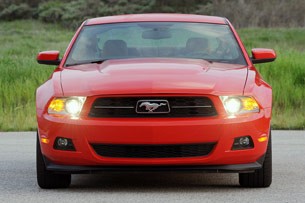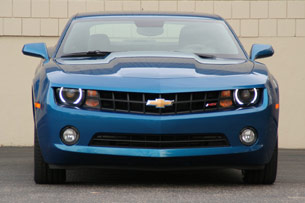Gearheads the world over have always talked in terms of horsepower. The bigger the number, the better we like it. The type of engine and its output are always one of the first statistics covered in any test drive or car review, because we want to know!
But our fixation on horsepower is kind of a meaningless metric. Just because a car has a big engine, or big output, doesn't necessarily mean it will perform well. Conversely, a car with a small engine and modest output can actually be a blast to drive.
It all depends on how much weight that engine has to lug around. And that's why, as enthusiasts, we should be looking at the power-to-weight ratio of a vehicle to get an idea of its potential performance. That is far more revealing than knowing the horsepower or torque.
It's an easy calculation. All you have to do is look up the curb weight of a car and divide it by the horsepower that the engine puts out. Or if you speak metric, you can divide kilowatts into kilograms.
I know you purists out there will deride me for calling this a power-to-weight ratio, instead of weight-to-power. But saying "power-to-weight" just trips off the tongue more naturally. Besides, it's easier to remember how many pounds an engine has to lug around, rather than trying to figure out fractions of a horsepower per pound.
John McElroy is host of the TV program "Autoline Detroit" and daily web video "Autoline Daily". Every week he brings his unique insights as an auto industry insider to Autoblog readers.
Here's an example of what I'm talking about. The 2011 Ford Mustang with the new 3.7 liter V6 is rated at 305 horsepower, one more horsepower than the 304 hp that comes out of the Chevy Camaro's 3.6-liter V6. One more horsepower, you might say, who cares?
Well, the base Mustang is nearly 300 pounds lighter than a comparable Camaro. That means the Mustang has to lug around 11.3 pounds per horsepower, compared to the 12.3 pounds in the Camaro. Or, to write it as a ratio, the Mustang is at 1:11.3, while the Camaro is at 1:12.3. That is a significant difference, and indicates the Mustang will easily blow the doors off the Camaro despite having only one more pony under the hood.


Here's another example. Which vehicle would you think accelerates faster? The Ram Power Wagon with a 5.7-liter Hemi V8 that pumps out 383 horsepower? Or a Nissan Altima hybrid with 198 horsepower (combined with its electric motor)? According to Motor Trend, the hoary Power Wagon takes 8.5 seconds to accelerate from 0 to 60 miles an hour. The milquetoast Altima hybrid does it in 7.1 seconds. See? It's about power-to-weight, not raw horsepower.
My staff put together a simple little chart that lets you estimate the probable 0-60 time a vehicle might generate, based on its power-to-weight ratio. It sure is a lot better predictor than just knowing the horsepower.

We're never going to give up talking about horsepower. It's just ingrained in our psyche. But by adding power-to-weight ratios to our discussions we can gain a lot more insight into the cars we're talking about.
Autoline Detroit
Airs every Sunday at 10:30AM on Detroit Public Television.
Autoline Detroit Podcast
Click here to subscribe in iTunes
Follow Autoline on Twitter for ongoing updates every day!
Subscribe | | | | Listen on Phone
But our fixation on horsepower is kind of a meaningless metric. Just because a car has a big engine, or big output, doesn't necessarily mean it will perform well. Conversely, a car with a small engine and modest output can actually be a blast to drive.
It all depends on how much weight that engine has to lug around. And that's why, as enthusiasts, we should be looking at the power-to-weight ratio of a vehicle to get an idea of its potential performance. That is far more revealing than knowing the horsepower or torque.
It's an easy calculation. All you have to do is look up the curb weight of a car and divide it by the horsepower that the engine puts out. Or if you speak metric, you can divide kilowatts into kilograms.
I know you purists out there will deride me for calling this a power-to-weight ratio, instead of weight-to-power. But saying "power-to-weight" just trips off the tongue more naturally. Besides, it's easier to remember how many pounds an engine has to lug around, rather than trying to figure out fractions of a horsepower per pound.
John McElroy is host of the TV program "Autoline Detroit" and daily web video "Autoline Daily". Every week he brings his unique insights as an auto industry insider to Autoblog readers.
Here's an example of what I'm talking about. The 2011 Ford Mustang with the new 3.7 liter V6 is rated at 305 horsepower, one more horsepower than the 304 hp that comes out of the Chevy Camaro's 3.6-liter V6. One more horsepower, you might say, who cares?
Well, the base Mustang is nearly 300 pounds lighter than a comparable Camaro. That means the Mustang has to lug around 11.3 pounds per horsepower, compared to the 12.3 pounds in the Camaro. Or, to write it as a ratio, the Mustang is at 1:11.3, while the Camaro is at 1:12.3. That is a significant difference, and indicates the Mustang will easily blow the doors off the Camaro despite having only one more pony under the hood.


Here's another example. Which vehicle would you think accelerates faster? The Ram Power Wagon with a 5.7-liter Hemi V8 that pumps out 383 horsepower? Or a Nissan Altima hybrid with 198 horsepower (combined with its electric motor)? According to Motor Trend, the hoary Power Wagon takes 8.5 seconds to accelerate from 0 to 60 miles an hour. The milquetoast Altima hybrid does it in 7.1 seconds. See? It's about power-to-weight, not raw horsepower.
My staff put together a simple little chart that lets you estimate the probable 0-60 time a vehicle might generate, based on its power-to-weight ratio. It sure is a lot better predictor than just knowing the horsepower.

We're never going to give up talking about horsepower. It's just ingrained in our psyche. But by adding power-to-weight ratios to our discussions we can gain a lot more insight into the cars we're talking about.
###
Autoline Detroit
Airs every Sunday at 10:30AM on Detroit Public Television.
Autoline Detroit Podcast
Click here to subscribe in iTunes
Follow Autoline on Twitter for ongoing updates every day!
The video meant to be presented here is no longer available. Sorry for the inconvenience.
Subscribe | | | | Listen on Phone


Sign in to post
Please sign in to leave a comment.
Continue